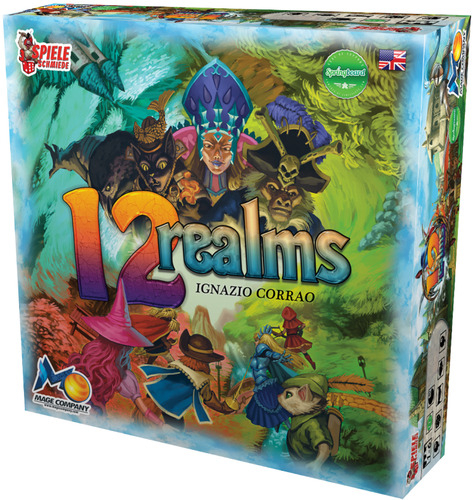
The Basics:
- For ages 6 and up (publisher suggests 11+)
- For 1 to 6 players
- Approximately 90 minutes to complete
Geek Skills:
- Active Listening & Communication
- Counting & Math
- Logical & Critical Decision Making
- Reading
- Pattern/Color Matching
- Strategy & Tactics
- Risk vs. Reward
- Cooperative & Team Play
- Hand/Resource Management
Learning Curve:
- Child – Easy
- Adult – Easy
Theme & Narrative:
- Take on the role of a Hero and save the magical realms from invading forces!
Endorsements:
- Gamer Geek approved!
- Parent Geek approved!
- Child Geek approved!
Overview
The magical realms are at peace. Travelers and merchants cross the boarders freely and all share in the bounty. When scattered reports and rumors began to circulate of invaders, many couldn’t believe it. After all, the realms have never known war. When the first invading forces torched a small village, the magistrates of each realm called for heroes to fight for and defend their homes. The heroes heard the call and now march to war for the first time in the history of the realms. The future is very uncertain…
12 Realms, designed by Ignazio Corrao and published by MAGE Company, is comprised of 4 Realm Map boards, 18 Cherry Blossom Invaders, 20 Silver Kingdom Invaders, 18 Fairy Forest Invaders, 20 Bones Island Invaders, 76 Realm cards (19 Fairy Forest cards, 19 Cherry Blossom cards, 19 Bones Island cards, and 19 Silver Kingdom cards), 8 Heroes, 4 Invasion markers, 20 Town cards, 10 Promo Town cards, 12 Event cards, 12 Artifact tokens, 12 Treasure tokens, 40 Coins, 1 Inn token, 6 Inn cards, 1 Bazaar token, 6 Bazaar cards, 1 Stable token, 6 Stable cards, 48 Heroes Talent tokens, 40 Extra Talent tokens, 12 Special Talent tokens, 1 Talent die, 1 Area die, and 1 Realms Guide. PHEW! That’s a lot of bits! The cardboard pieces and cards are durable and colorful. The miniatures are very well made and look even better when painted.
Game Set Up
To set up the game, first give each player 1 Realm Map board. Place any Realm Map boards not selected back in the game box.
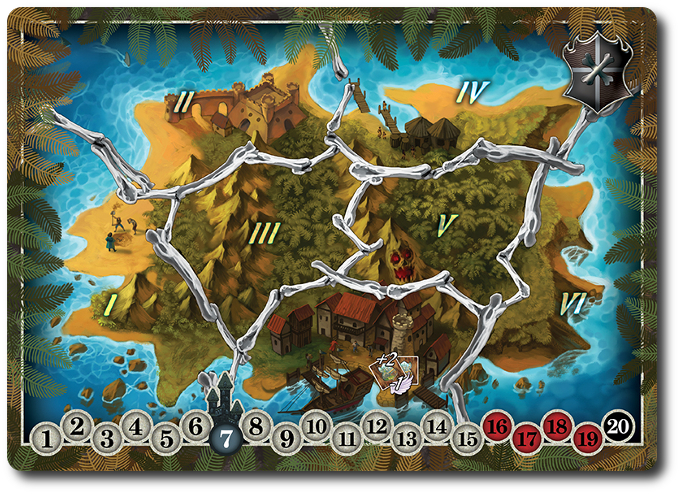
Example Realm Map board: Bones Island (my favorite)
Second, remove any Realm cards that are not affiliated with the selected Realm Map boards. Place the removed Realm cards back in the game box.
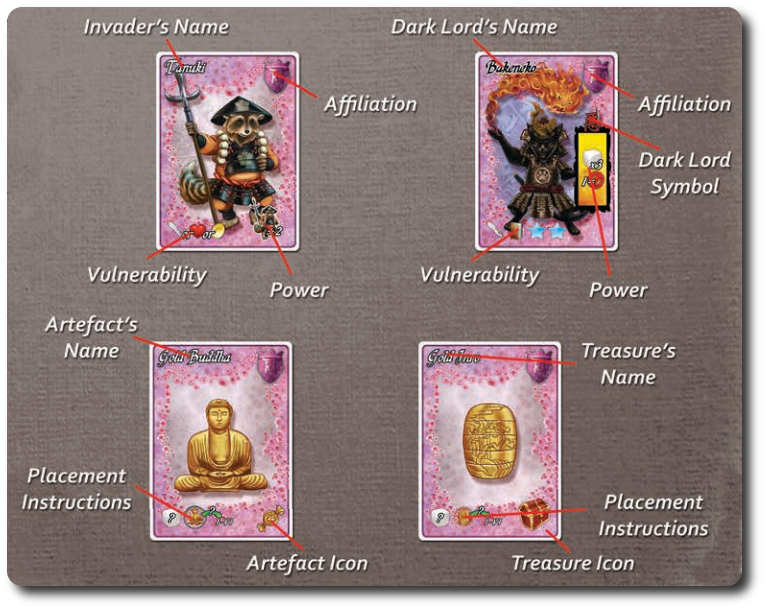
Example of Realm cards
Third, from the kept Realm cards, remove the Lords of Darkness cards and select 1 per Realm Map board. Place the selected Lord of Darkness cards next to their affiliated Realm Map board. Place the Lords of Darkness cards not used back in the game box.
Fourth, find and place the round Artifact and Treasure tokens, as well as the square Invader and Lord of Darkness tokens next to the affiliated Realm Map board. For example, the 18 Forest Invaders should be placed next to the Fairy Forest Realm Map board. Place any unused Artifact, Treasure, and Invader tokens back in the game box. Give each player 1 Invasion marker and have them place it next to the “1” space on their Realm Map board’s invasion tracker.
Fifth, shuffle the Realm cards and place the deck, face-down, within easy reach of all the players. Shuffle the Town deck and place it next to the Realm deck, face-down.
Sixth, have each player select a Hero card and place it in front of them. Each player should take the matching Hero miniature and place the miniature in the Town space of their Realm Map board. Any Hero cards and miniatures not used should be placed back in the game box.

Seventh, place 1 red Talent token on the Hero card for every main talent listed. Place any unused Talent tokens (both red and blue) to one side of the gaming area. Next to this pile, place the Coins.
Seventh, place 1 random Artifact token and 2 random Treasures tokens on each Realm Map board.
That’s it for game set up. Time to save the realms!
Repelling the Invaders
12 Realms is played in turns with each turn being comprised of phases, steps, and actions. During each turn, the starting player will take all their actions followed by the next player in turn order sequence. During a single game turn, players will be working together to defend their realms and repel the invading dark armies. A typical game turn is summarized here.
Note: I will only be summarizing the game in this review. For complete rules and instructions, refer to the game’s rule book.
Phase 1: Invasion
At the start of each turn, the realms are invaded. How well the players did during the last turn will determine how much more threat they have to manage.
Step 1: Update Invasion Track
Located at the bottom edge of each Realm Map board is an invasion track. The Invasion marker moves along this track as the game progresses, measuring the overall “darkness” that has crept into the realm. Players should count how many Invader tokens are currently in their realm and move the Invasion marker that many spaces forward. For example, if the player has 5 Invader tokens scattered about their Realm Map board, they would move the Invasion maker 5 spaces forward on the Invasion track.
Note that each Realm Map board keeps track of its own invasion level.
Step 2: Resolve Powers
Some invaders have powers that are now resolved. For example, the “Ghost Pirate” Invader has the “Curse” power that forces players on the same Realm Map board to exploit (spend) 1 randomly rolled talent. Powers are listed on the Invader’s matching Realm card.
Step 3: Draw Realm Cards and Place on Realms
Two Realm cards per realm, plus 1 additional realm card, are now drawn. For example, if playing with 2 Realm Map boards, you would draw 5 Realm cards. Each Realm card should be resolved one at a time. When drawing an Invader, Artifact, or Treasure, roll the Area die and place the respective token in the affiliated Realm Map board space.
For example, if you drew the “Ghost Pirate”, you would roll the Area die and then place the “Ghost Pirate” Invader token in that area space on the “Bones Island” Realm Map board. If there are no more tokens for the Invader, Artifact, or Treasure depicted, simply skip the card.
Note that some Invaders have powers that immediately come into play. For example, Invaders with the “Horde” power will bring an “X” number of additional Invaders of the same type, where “X” is the number on the Realm card.
Phase 2: Perform Actions
Now the players get to fight back. Each player can take any number of actions as long as they have the available Talent token to exploit. Exploiting Talent tokens simply “spends” them temporary during the turn. Once the player is out of Talent tokens, they can no longer take any actions. Players are never forced to take any actions if they don’t want to and can end their actions at any time.
Talents include…
- Charm (heart icon)
- Combat (sword icon)
- Swiftness (wing icon)
- Magic (star icon)
- Craft (book icon)
- Gold (coin icon)

Exploiting the talents, the player then takes actions. Actions include, but are not limited to…
- Move: For 1 “Swift” Talent token, the player can move their Hero from one space on the Realm Map board to an adjacent space.
- Confront Invader: When confronting an Invader, the Invader must be located in the same Realm Map board space as the Hero. To remove the Invader token, the player need only exploit the talents listed on the Invader’s token (also duplicated on the Realm card). If the player has the available Talents, they are exploited and the targeted Invader token is removed from the Realm Map board.
- Claim a Treasure: If the Treasure token is located in the same Realm Map board space as the Hero, the player can exploit the necessary Talent token to claim the Treasure token. Once removed, the player collects 1 Coin.
- Claim an Artifact: If the Artifact token is located in the same Realm Map board space as the Hero, the player can exploit the necessary Talent token to claim the Artifact token.
- Trade Artifacts: Heroes located in the same Realm Map board space can exchange any number of Artifacts between themselves.
- Visit Town: If the Hero is located in the “Town” Realm Map board space, they can spend 1 “Swift” Talent to draw 2 Town cards. From these 2 cards, they select 1 and pay the listed amount of Coins to obtain the card. The equipment and bonuses provided by the cards are immediately available to the player.
- Realm Travel: If the Hero is located in the “Town” Realm Map board space, they can move their Hero to any other “Town” Realm Map board space. However, doing so immediately ends the player’s actions.
Purchased equipment can provide additional actions that the player can use to defend the realms. Some Hero’s also have special actions that they can perform.
Phase 3: Refresh
Finally, at the end of the turn, all the players now return their exploited Talent tokens to their starting position on their Hero’s main talent portion of the card.
This completest the turn. A new turn now beings starting with phase 1 noted above.
The Lords of Darkness
When a realm’s Invasion marker moves into the red marked areas (numbers 16 and up), the realm is invaded by the affiliated Lord of Darkness. Like the Invader tokens before it, the Lord of Darkness token is randomly placed on the Realm Map board. To remove the Lord or Darkness, at least 1 player must have all 3 Artifacts affiliated with that realm. If they do, then all they need to do is exploit the correct number and type of Talents to defeat the Lord of Darkness. Other players can assist in the effort by offering Talents, but only the player with the Artifacts (referred to as the “leader”) will be the one to strike the final blow.
If the Lord of Darkness is defeated, the realm is free from dark tyranny and decay brought about by the darkness forever. All the Invader and the Lord of Darkness tokens for that affiliated realm are removed from play. If a Realm card depicts the realm that is now forever free of evil, the card is simply ignored. Players can now focus on saving other realms.
Victory and Defeat
As this is a Cooperative game, all the players either win or all the players lose. If an Invasion marker in any realm moves past 20, the players have lost. With the defeat of one realm, the others quickly follow. If, however, the players are able to crush all the Lords of Darkness and keep the Invasion markers to 20 or less, then they have won the game.
Game Variants
A number of variants are provided with the game that allow for different game set ups, play styles, and challenges.
Going Solo
12 Realms can easily be played as a Solitaire game. Simply select 1 Realm Map board, 1 Hero, and begin. The game rules are the same except that players should draw 2 Realm cards for a game considered “normal difficulty” or 3 for a much more difficult game.
Black Fortress
This game variant introduced a Black Fortress that serves to protect the Invaders and cause nothing but problems for the Heroes. When the Invasion marker for a realm moves to “7” or higher, the Black Fortress is placed on the Realm Map board. Until the Black Fortress is removed, no other Invaders in the same Realm Map board space as the Black Fortress can be attacked. Additionally, new Invaders to the realm are always placed in the same Realm Map board as the Black Fortress!
Buildings and Trade
Three additional buildings (the Stable, Inn, and Bazaar) can be placed on the Realm Map boards and provide the Heroes additional gear to defend the realms.

The Dark Player
As if the game wasn’t difficult enough already, players can opt to put one of their own to direct the forces of darkness. The Dark Player controls the Realms deck (placing the Invaders, Tokens, and Artifacts as normal) and the Event cards. Event cards can be both beneficial and detrimental to the Heroes and their cause. Most of the time, however, the Dark Player is going to play Event cards that cause nothing but misery.
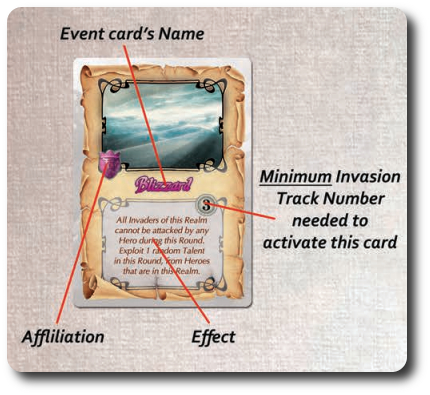
The Crap
After defeating the Lord of Darkness in the “Bones Island” realm, a small crab wearing a pirate hat follows the “lead” player who slew the dark lord. This follower provides Talents that can be used to help save the other realms.
Adjust Difficulty
The rules above describe the “Basic” game which is considered “easy”. Several suggestions on slight variations of the game set up are listed that adjust the game’s difficulty. For example, for a “very easy” game, the basic game is set up along with 3 Buildings. If the players want to play a difficulty level noted as “nightmare”, they would set the game up with the Black Fortress, the Dark Player, the Crap, and the Buildings.
To learn more about 12 Realms, visit the game’s web page.
Prediction
This is a game I’ve been wanting to get to the table for a long time. Ever since the game arrived, it has been the focus of discussion between our players. When the timing was finally right to play it, I had a number of players begging me to be the first to give it a try. If we were the predict a game’s level of success based only on the level of excitement the players have to play it, then 12 Realms should be endorsed by all 3 of our groups. But let’s dig a bit deeper than pure fandom…
12 Realms is a Cooperative game, which always does well with the Child and Parent Geek groups. Games where families can work together (instead of competing against each other) provide a less hostile and aggressive environment at the family gaming table. Of course, aggressive plays are exactly the kind of thing that Gamer Geeks enjoy, so one would think that Gamer Geeks would be less inclined to enjoy Cooperative games. You would be wrong, however, to think so. Cooperative games are designed to beat the player and out think them. Gamer Geeks very much enjoy this kind of challenge and the way they have to go about managing growing threat as a team. In almost all cases, Cooperative games have been given full endorsements by all 3 of groups with very few exceptions. I see no reason why 12 Realms won’t also be fully endorsed.
Teaching 12 Realms is surprisingly simple. The bulk of the game would suggest that its game play is heavy and complex. In actuality, the most complex aspect of the game is simply knowing how best to exploit talents when it’s the player’s turn. Luckily, a player never need make choices in a vacuum and their fellow players can provide suggestions and even assistance. And on that point, make sure you inform your players that 12 Realms is won as a team, but each individual is responsible for their own Hero. Don’t let one player attempt to dominate the others.
And so, after teaching 12 Realms to my 6 and 9-year-old, I asked them their thoughts on the game so far.
“It’s a great looking game and the rules sound easy enough. Looking forward to tackling evil!” ~ Liam (age 9)
“I’m the Nutcracker! Let’s crack some nuts!” ~ Nyhus (age 6)
My little geeks are ready to save the realms! Let’s play the game and see if it’s worth the effort.
Final Word
The Child Geeks had a great time playing 12 Realms. They played smart, exploited their Talents in a way that seemed efficient, and did their very best to help all the realms. According to one Child Geek, “What I like best about this game is all the different kinds of enemies that you get to fight!” Another Child Geek said, “I like games where we get to work together. I like the game because of that.” All the Child Geeks voted to approve 12 Realms and a few of the older Child Geeks even attempted more complex games and even a solo game or two. All were enjoyed, if not won.
The Parent Geeks found 12 Realms to be a great game to play with the family. Not so much with their peers, but a great game at the gaming table with a mix of Child and Parent Geeks. According to one Parent Geek, “This is a great game with a great theme and fantastic miniatures. I would enjoy playing it just because it looks great.” But looks aren’t everything. According to another Parent Geek, “I was afraid this game was all looks and no show, but the game play is really straightforward and intuitive. I had fun playing the game and would play it again.” All the Parent Geeks voted to approve 12 Realms.
The Gamer Geeks were a bit skeptical when I showed them some of the artwork in the game. “Red Riding Hood? Seriously, Cyrus?” Some of the “cute” artwork didn’t play well with the hardcore gamers, but every Gamer Geek approved of the high quality and highly detailed miniatures. In fact, I was told on several occasions how badly I botched up the game because I didn’t paint the miniatures before we played. Be that as it may, the game was very much enjoyed and the Gamer Geeks were both challenged and entertained in equal measure. According to one Gamer Geek, “Nothing wrong with this game. It’s a solid Cooperative game. I don’t feel that it introduced anything new, but the game play is very smooth.” Another Gamer Geek said, “This is a great example of a game that plays smart, challenges you, and can be played a variety of ways. It’s a good game.” And my favorite quote from a Gamer Geek, “It’s OK”, which means the game was pretty good, according to this particular Gamer Geek who is a man of few words. All the Gamer Geeks endorsed 12 Realms.
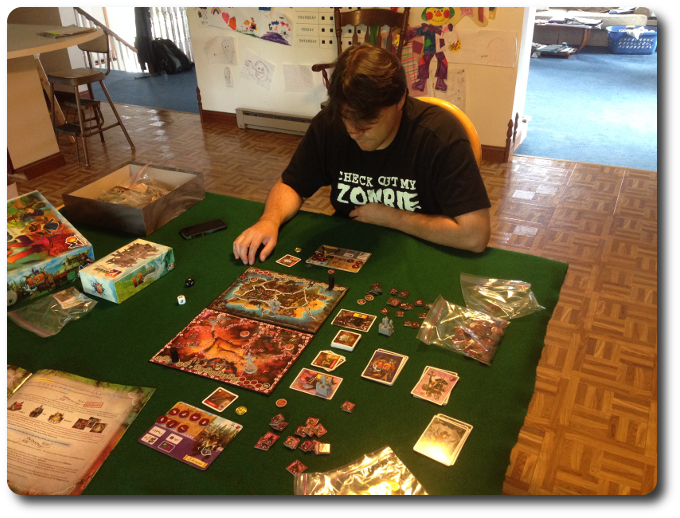
A fellow Gamer Geek looks over the realms, planning the next attack
I should also note that every player we introduced 12 Realms to noted that the game only came with 4 realms. You just know there are going to be expansions…
12 Realms is going to be a game you either enjoy or just don’t care about. The rules are a bit difficult to navigate at times and the updated FAQ is a must read. Overall, the game play is solid and the game’s difficulty ramps up fairly well. A bit slow at times, especially when playing with 5 or more players, but the pacing will keep players engaged. I personally found the game’s theme to be imaginative and the method in which players reduce the threat level to be a bit simplistic. But simplicity is good when you want to play a game with a mixed group of players. I don’t think 12 Realms will go down in the record books as the “most difficult Cooperative game” in history, but it certainly will be noted as an enjoyable one. Do sit down for a game or two of 12 Realms if the opportunity presents itself.
This game was given to Father Geek as a review copy. Father Geek was not paid, bribed, wined, dined, or threatened in vain hopes of influencing this review. Such is the statuesque and legendary integrity of Father Geek.
Discover more from Father Geek
Subscribe to get the latest posts sent to your email.






Pingback: In Review: Father Geek’s Monthly Newsletter (April 2014) » Father Geek
Pingback: In Review: Father Geek’s Monthly Newsletter (June 2014) » Father Geek
Pingback: In Review: Father Geek’s Monthly Newsletter (July 2014) - Father Geek